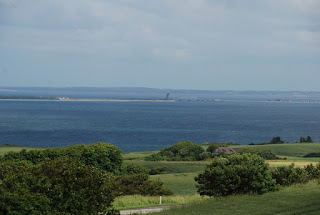Today
was planned as our longest journey of our visit to Denmark. We were heading for
Aalborg in Northern Jutland but wanted to take in some of the scenery of the
west of Jutland. We had identified a castle and a couple of museums that we
could take in on the way but decided to concentrate on the scenery instead.
After going round Ebsjerg, we headed for the coastal side of the Ringkobing
Fjord. I should explain that you mustn’t think of Norwegian fjords, Jutland is
essentially flat and the fjords are essentially large lakes with a connection
to the sea. The coastal strip is a huge sandbar with vast sand dunes and, in
some areas, nestling in amongst them are large numbers of holiday homes. We
wondered what their house insurance cost as there must be considerable risk of
sand invasion or flood damage during winter storms. The area is very beautiful
and we found a car park well away from the main road where we could easily walk
to the sea. The weather was sunny but the wind was vicious!
We
continued north past a couple of small fjords and then the larger Nissum Fjord
before heading inland to Lemvig.
Just
a few kilometres east from Lemvig, close to a vast area of sea called Nissum
Bredning, we stopped for lunch at viewpoint with 360° views inland and over the
Nissum Bredning to the land beyond. This is an important shipping lane right
through the islands that make up northern Jutland. We continued north over a
bridge and then next to more fjords and brednings until we arrived at Aggersund
at the western end of Limfjord. Here there is a large Viking ring fort, built
by Harald Bluetooth, consisting of a large bank and ditch that encloses a very
large area used to house a settlement. The fort commands extensive views over
Limfjord and Logster Bredning and is at the pinch point between them, giving
control over any ships navigating between.
Using
the bridge south over the strait, we then turned east, heading to Aalborg and Aalborg
Camping.
Photos:
Jane sporting a new hairstyle – caused by a vicious westerly wind; Nature in
the raw and lots and lots of sand, inland as well as on the beach; We are very
relaxed and don’t mind occasional minor delays and this one at a fjord’s
opening to the sea was fun; Part of the 360° view from our lunch spot – you may
just be able to make out a bridge raised in the background and this is the
bridge that we crossed after lunch; Aggersborg Viking ring fort in its
commanding position overlooking the strait.




















